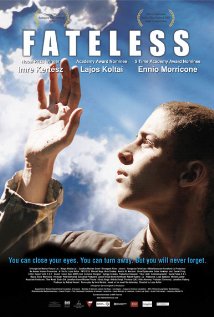
Fateless (2005 movie: Hungary)

A link to my post on the novel
From The New York Times: a review of the movie and an article on Kertész and the movie (both of which I’ll reference in the post)
Since I posted so much about the book in the link above I’ll try and keep this post short. Since Imre Kertész wrote the novel and the screenplay, the differences between the two (as well as how they took advantage of the different medium) are what I will focus on in this post.
The first thing noted in The New York Times review is what impressed me about the movie—how can you make a film about the Holocaust be so visually beautiful? The colors are muted in the beginning, with exceptions like the yellow stars, and become even more washed out as the story unfolds. This muting allows for a potent use of light and color, such as allowing brighter light and golds during Gyuri’s (Georg’s) “golden hour” in the camps. Many scenes don’t need dialogue or even actors since the shot speaks volumes. Powerful scenes like this include Gyuri’s grandfather’s facial expressions during his son’s “going away to the labor camp” dinner or the focus on the luggage and coats piled up next ot the railcars at Auschwitz.
So how do you convey what is going on in the inner mind, where so much of the novel takes place? Voiceover provides many of thoughts, but Kertész also added scenes to show Gyuri ascribing humanity during the dehumanization process:
- The job foreman tries to intercede on the kids’ behalf after they are rounded up by the police.
- The policeman leading them to the train station indicates to Gyuri he should take off during an opportune moment.
- An entertainment scene is added during their transport, effectively making the surreal even more strange.
- In the novel Gyuri talks about being hungry and watching the guards eat. There is a great scene where Gyuri gets vicarious pleasure watching a guard eat—while watching the guard Gyuri mimics him, remembering what it felt like to eat. The German notices this and turns his back to Gyuri, depriving him of the pleasure he was experiencing but also sparing him the torment.
- An American soldier(Daniel Craig) tells Gyuri he should get off the transport before he gets home since they would be handed over to Soviet soldiers, one of the few explicit uses of foreshadowing.
Like the novel, Gyuri’s return to Budapest is only a small portion of the film but it is very moving and highlights the disconnect from what he just went through. He sees a former helper to the SS preventing a lynching. The contrasting messages Gyuri receives are clear, with the journalist wanting to publish the message of what happened while family members, defensive and rationalizing, encourage him to put the past behind him. The added image of women at the train station holding portraits, wanting word of their loves ones, is a powerful visual to offset the call to forget.
In The New York Times article Kertész talks about writing the screenplay:
“The film is more autobiographical than the book,” he said in an interview at his Berlin home, where his wife, Magda, volunteered to interpret his Hungarian. “I’m not even sure if I wrote the screenplay from memories or from memories of the book.”
I’m not sure what he means by “more autobiographical” since the novel and the film follow each other closely, unless certain added scenes were from experiences. He does mention the Daniel Craig’s character was a composite of many American soldiers encouraging him not to return home.
These are the types of adaptations I take pleasure in watching after I’ve enjoyed a book, where scenes may be added or excised but the overall spirit is maintained while successfully taking advantage of the different medium.
Brian Joseph
I am a bit of a movie buff but have not seen it yet. Your commentary has made me want to as it seems to have some non conventional aspects to the story.
Dwight
Fortunately much of the non-conventional aspects come from the novel or, if not explicitly from it, from the spirit of the novel. I definitely recommend it.